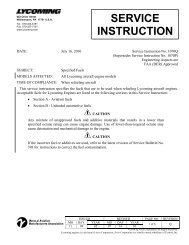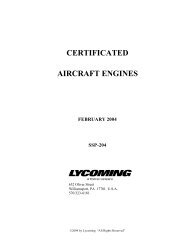Create successful ePaper yourself
Turn your PDF publications into a flip-book with our unique Google optimized e-Paper software.
the combustion chamber to dilute the fuel/air mixture. The dilution<br />
will reduce the octane rating of the fuel and can lead to detonation<br />
and engine damage. While this scenario is not entirely typical of<br />
the engine that uses large amounts of oil because of worn or broken<br />
piston rings, it is possible for this situation to occur.<br />
Even the use of 100 octane fuel in an engine in good mechanical<br />
condition does not eliminate all the possibilities of induced<br />
engine damage. Most engines operated at takeoff power or at<br />
a power setting in the high cruise range need a relatively rich<br />
fuel/air mixture to help cool the engine and reduce possibilities<br />
of detonation. Since lean fuel/air mixtures and high power settings<br />
promote detonation, it is recommended that <strong>Lycoming</strong><br />
engines not be leaned at power settings which produce more than<br />
75% of rated engine power unless this operation is approved in<br />
the POH. The pilot, by simply leaning the mixture excessively at<br />
power settings above the cruise ranges, may be responsible for<br />
inducing the detonation and preignition which leads to tuliped<br />
valves and burned pistons.<br />
And finally, a small amount of dirt in the fuel system may<br />
be responsible for clogging a fuel injector nozzle or nozzles.<br />
A partially clogged fuel injection nozzle will reduce fuel<br />
flow to that cylinder and will cause a lean fuel/air mixture.<br />
A nozzle which is partially clogged in an aircraft that has a pressure<br />
operated fuel flow indicator will cause that indicator to display<br />
a higher than normal fuel flow. Leaning in an attempt to correct<br />
the high indicated fuel flow will result in an even leaner mixture<br />
in the affected cylinder. Again, it is possible that a burned piston<br />
or tuliped valve will be the final result.<br />
Understanding and avoiding those factors which lead to in-<br />
duced engine damage is certainly preferable to the discovery<br />
of tuliped valves or burned pistons in your engine. This<br />
entire discussion is aimed at promoting an understanding which<br />
will allow pilots and maintenance personnel to direct their efforts<br />
to those elements which will reduce the possibility of induced engine<br />
damage. Observing the refueling of the aircraft and checking<br />
the fuel system for indications of contamination are<br />
tasks expected of the pilot. Meticulous management of power<br />
and fuel/air mixture as recommended by the POH is also a pilot<br />
activity which will reduce the possibility of induced damage.<br />
Maintenance personnel play an equally important role.<br />
Troubleshooting a fuel-injected engine for rough idle may lead to<br />
the cleaning or changing of partially clogged fuel injector nozzles.<br />
Damage could result if the engine were operated at takeoff or<br />
climb power with reduced fuel flow to one or more cylinders. A<br />
close check of magneto timing and magneto condition at regular<br />
inspection intervals will help to ensure the continued satisfactory<br />
operation of any engine.<br />
There are some “after-the-damage” factors that maintenance<br />
personnel should consider. Suppose that a power loss has<br />
been reported. A compression check reveals low compression;<br />
a stretched or tuliped valve may be found. This is an indication<br />
that the engine has experienced detonation and preignition.<br />
A borescope examination should be conducted to see if a piston<br />
has been burned. A burned piston often results in damage to cylinder<br />
walls and piston skirts; it also may contaminate the engine<br />
with metal particles. There is no healing process for this damage.<br />
In some cases, it is possible to repair the engine by removing the<br />
metal contamination from the engine and oil system, including<br />
the oil cooler, and by replacing all damaged parts, but often it<br />
is necessary to replace the entire engine. If an engine is to be<br />
repaired, it must be remembered that repairing the damage is not<br />
enough; the cause of the malfunction which induced detonation<br />
and preignition must also be found and corrected. Did a magneto<br />
malfunction produce ignition outside the normal firing sequence?<br />
Were manufacturer-approved spark plugs installed in the engine?<br />
Did a cracked spark plug induce preignition? Was an approved<br />
fuel used, and if so, is there evidence of fuel contamination?<br />
Whatever the malfunction, it must be corrected along with the<br />
damage or the same problem could reoccur.<br />
To conclude, induced damage in the form of tuliped valves and<br />
burned pistons can usually be avoided by understanding the<br />
sequence of events which lead to this form of engine damage.<br />
Careful attention to detail is required of pilots and maintenance<br />
personnel. Compared to the expense of repairing or replacing a<br />
damaged engine, it is worth the time and effort necessary to avoid<br />
induced engine damage.<br />
We often tend to believe what we know, everyone knows. While<br />
participating in a flight instructor refresher recently, a young lady<br />
from Maine provided a reminder that this is often not the case.<br />
This lady and her husband fly in Maine throughout the year.<br />
During the winter, they and their aircraft are frequently exposed<br />
to extremely cold temperatures. During the past winter, they had<br />
an unfortunate experience. The end of the engine breather tube<br />
froze over, a pressure buildup occurred in the crankcase, and the<br />
crankshaft nose seal ruptured. The oil leak that resulted covered<br />
the aircraft with oil from nose to tail. Fortunately, a safe landing<br />
was made before all oil was lost.<br />
As she related her story, another flight instructor quickly indicated<br />
that he had also experienced the same problem several years<br />
earlier. The safe landings in both cases are good news. The bad<br />
news is the expense incurred to repair the engine.<br />
An incident like this is preventable, and for that reason, it is<br />
important that we repeat ourselves from time to time. We should<br />
not assume that everyone knows about the “whistle slot” or<br />
other methods of ensuring adequate crankcase venting.<br />
First, the cause of this incident. Moisture is expelled from the<br />
engine crankcase through the breather tube which often extends<br />
through the bottom of the engine cowling into the airstream.<br />
Under very cold conditions, this moisture may freeze and continue<br />
a buildup of ice until the tube is completely blocked.<br />
It is normal practice for the airframe manufacturer to provide<br />
some means of preventing freeze-up of the crankcase breather<br />
tube. The breather tube may be insulated, it may be designed so<br />
the end is located in a hot area, it may be equipped with an electric<br />
heater, or it may incorporate a hole, notch or slot which is often<br />
L y c o m i n g F l y e r







